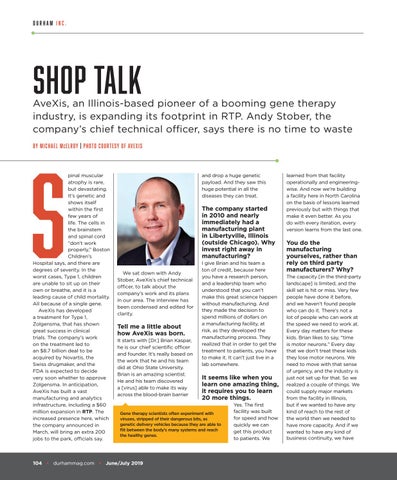durham inc.
SHOP TALK
AveXis, an Illinois-based pioneer of a booming gene therapy industry, is expanding its footprint in RTP. Andy Stober, the company’s chief technical officer, says there is no time to waste BY M I C H A E L M C E L R OY | P H O T O C O U R T E SY O F AV E X I S
S
pinal muscular atrophy is rare, but devastating. It’s genetic and shows itself within the first few years of life. The cells in the brainstem and spinal cord “don’t work properly,” Boston Children’s Hospital says, and there are degrees of severity. In the worst cases, Type 1, children are unable to sit up on their own or breathe, and it is a leading cause of child mortality. All because of a single gene. AveXis has developed a treatment for Type 1, Zolgensma, that has shown great success in clinical trials. The company’s work on the treatment led to an $8.7 billion deal to be acquired by Novartis, the Swiss drugmaker, and the FDA is expected to decide very soon whether to approve Zolgensma. In anticipation, AveXis has built a vast manufacturing and analytics infrastructure, including a $60 million expansion in RTP. The increased presence here, which the company announced in March, will bring an extra 200 jobs to the park, officials say.
and drop a huge genetic payload. And they saw this huge potential in all the diseases they can treat.
The company started in 2010 and nearly immediately had a manufacturing plant in Libertyville, Illinois (outside Chicago). Why invest right away in manufacturing? We sat down with Andy Stober, AveXis’s chief technical officer, to talk about the company’s work and its plans in our area. The interview has been condensed and edited for clarity.
Tell me a little about how AveXis was born. It starts with [Dr.] Brian Kaspar, he is our chief scientific officer and founder. It’s really based on the work that he and his team did at Ohio State University. Brian is an amazing scientist. He and his team discovered a [virus] able to make its way across the blood-brain barrier
I give Brian and his team a ton of credit, because here you have a research person, and a leadership team who understood that you can’t make this great science happen without manufacturing. And they made the decision to spend millions of dollars on a manufacturing facility, at risk, as they developed the manufacturing process. They realized that in order to get the treatment to patients, you have to make it. It can’t just live in a lab somewhere.
It seems like when you learn one amazing thing, it requires you to learn 20 more things.
Gene therapy scientists often experiment with viruses, stripped of their dangerous bits, as genetic delivery vehicles because they are able to flit between the body’s many systems and reach the healthy genes.
104 • durhammag.com • June/July 2019
Yes. The first facility was built for speed and how quickly we can get this product to patients. We
learned from that facility operationally and engineeringwise. And now we’re building a facility here in North Carolina on the basis of lessons learned previously but with things that make it even better. As you do with every iteration, every version learns from the last one.
You do the manufacturing yourselves, rather than rely on third party manufacturers? Why? The capacity [in the third-party landscape] is limited, and the skill set is hit or miss. Very few people have done it before, and we haven’t found people who can do it. There’s not a lot of people who can work at the speed we need to work at. Every day matters for these kids. Brian likes to say, “time is motor neurons.” Every day that we don’t treat these kids they lose motor neurons. We need to move with that sense of urgency, and the industry is just not set up for that. So we realized a couple of things. We could supply major markets from the facility in Illinois, but if we wanted to have any kind of reach to the rest of the world then we needed to have more capacity. And if we wanted to have any kind of business continuity, we have
